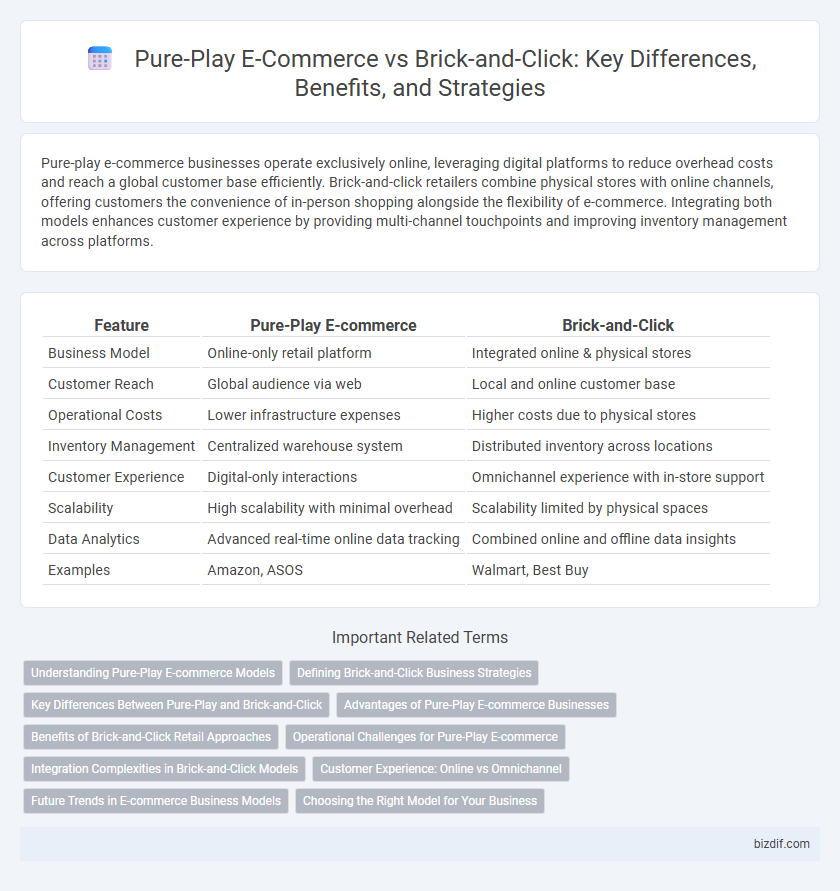Pure-play e-commerce businesses operate exclusively online, leveraging digital platforms to reduce overhead costs and reach a global customer base efficiently. Brick-and-click retailers combine physical stores with online channels, offering customers the convenience of in-person shopping alongside the flexibility of e-commerce. Integrating both models enhances customer experience by providing multi-channel touchpoints and improving inventory management across platforms.
Table of Comparison
| Feature | Pure-Play E-commerce | Brick-and-Click |
|---|---|---|
| Business Model | Online-only retail platform | Integrated online & physical stores |
| Customer Reach | Global audience via web | Local and online customer base |
| Operational Costs | Lower infrastructure expenses | Higher costs due to physical stores |
| Inventory Management | Centralized warehouse system | Distributed inventory across locations |
| Customer Experience | Digital-only interactions | Omnichannel experience with in-store support |
| Scalability | High scalability with minimal overhead | Scalability limited by physical spaces |
| Data Analytics | Advanced real-time online data tracking | Combined online and offline data insights |
| Examples | Amazon, ASOS | Walmart, Best Buy |
Understanding Pure-Play E-commerce Models
Pure-play e-commerce models operate exclusively online, leveraging digital platforms to reach a global customer base without physical stores, reducing overhead costs and increasing scalability. These models utilize advanced data analytics and personalized marketing strategies to enhance customer experience and streamline the sales funnel. Unlike brick-and-click businesses, pure-play e-commerce companies prioritize seamless website performance, mobile optimization, and fast logistics to maintain competitive advantage in the digital marketplace.
Defining Brick-and-Click Business Strategies
Brick-and-Click business strategies integrate physical retail stores with online platforms, creating an omnichannel shopping experience that enhances customer convenience and engagement. These strategies leverage in-store inventory for quicker fulfillment options like click-and-collect while utilizing digital marketing and data analytics to personalize customer interactions. Combining offline presence with e-commerce capabilities helps businesses increase brand loyalty and expand market reach in competitive retail landscapes.
Key Differences Between Pure-Play and Brick-and-Click
Pure-play e-commerce operates exclusively online, leveraging digital platforms to minimize overhead costs and reach a broad customer base through targeted online marketing strategies. Brick-and-click retailers combine physical storefronts with online channels, providing customers with the option to experience products in-store while also benefiting from the convenience of online shopping and integrated inventory management. Key differences include operational cost structures, customer engagement approaches, and inventory logistics, where pure-play models emphasize digital scalability and brick-and-click focuses on seamless omni-channel experiences.
Advantages of Pure-Play E-commerce Businesses
Pure-play e-commerce businesses benefit from lower operational costs by eliminating physical storefront expenses, allowing for competitive pricing and scalable growth. These businesses leverage advanced data analytics and digital marketing strategies to target customers more effectively and personalize user experiences. Enhanced agility in responding to market trends and consumer preferences enables pure-play e-commerce companies to innovate rapidly compared to traditional brick-and-click models.
Benefits of Brick-and-Click Retail Approaches
Brick-and-Click retail approaches combine the advantages of physical stores and online platforms, offering customers seamless omnichannel experiences that enhance convenience and trust. This model increases customer engagement through in-person interactions while leveraging digital analytics to personalize marketing and inventory management. Integrating physical presence with e-commerce infrastructure boosts brand visibility and drives higher sales conversions compared to pure-play e-commerce businesses.
Operational Challenges for Pure-Play E-commerce
Pure-play e-commerce businesses face significant operational challenges such as managing complex supply chains without physical storefronts, ensuring fast and reliable last-mile delivery, and handling high volumes of online customer service interactions efficiently. Unlike brick-and-click models, pure-play e-commerce lacks offline customer touchpoints, which requires advanced logistics technologies and robust digital infrastructure to maintain competitive service levels. Inventory management and demand forecasting become crucial to prevent stockouts and overstock situations, directly impacting customer satisfaction and profitability.
Integration Complexities in Brick-and-Click Models
Brick-and-click models face significant integration complexities due to the need to synchronize inventory, pricing, and customer data across physical stores and online platforms. This omnichannel approach requires robust IT infrastructure and seamless communication between disparate systems to ensure real-time updates and consistent customer experiences. Pure-play e-commerce businesses avoid these challenges by operating exclusively online, enabling faster scalability and streamlined operations without the burden of integrating physical retail components.
Customer Experience: Online vs Omnichannel
Pure-play e-commerce offers customers seamless online navigation, personalized recommendations, and 24/7 accessibility, enhancing convenience and tailored shopping experiences. Brick-and-click retailers integrate physical stores with online platforms, providing omnichannel benefits such as in-store pickups, easy returns, and real-time inventory checks that enrich customer engagement and trust. Omnichannel strategies leverage data across channels to deliver consistent, cohesive experiences, driving higher satisfaction and loyalty compared to solely digital interactions.
Future Trends in E-commerce Business Models
Pure-play e-commerce models leverage advanced technologies like AI-driven personalization and seamless mobile integration to cater to evolving consumer demands, setting a fast pace for digital innovation. Brick-and-click businesses are increasingly investing in omnichannel strategies, combining physical retail advantages with robust online platforms to enhance customer experience and foster loyalty. Future trends indicate a convergence of digital and physical retail spaces through augmented reality, real-time inventory management, and data analytics to optimize operations and drive sales growth.
Choosing the Right Model for Your Business
Choosing the right business model between pure-play e-commerce and brick-and-click hinges on target audience, budget, and long-term scalability goals. Pure-play e-commerce offers lower operational costs and agility in digital marketing, ideal for startups focusing solely on online revenue. Brick-and-click combines the strengths of physical stores and online presence, providing enhanced customer experience and trust, crucial for brands seeking omnichannel integration and local market penetration.
Pure-Play E-commerce vs Brick-and-Click Infographic

 bizdif.com
bizdif.com